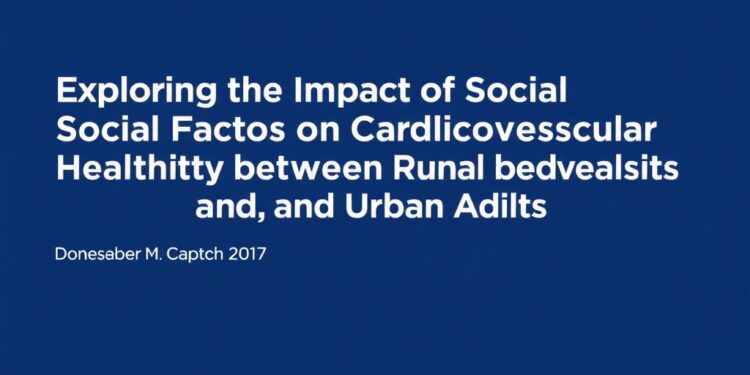In a groundbreaking study funded by the National Institutes of Health (NIH), researchers have unveiled significant disparities in cardiovascular health between adults residing in rural and urban areas of the United States. This research delves deep into societal factors that are believed to contribute to the higher incidence of heart disease among those living in rural communities, fundamentally reshaping our understanding of health inequalities across geographical boundaries. The investigation highlights critical variables such as income levels, educational attainment, food security, and home ownership, which together paint a troubling picture of cardiovascular health in rural populations.
The study assesses data drawn from the 2022 National Health Interview Survey, which encompassed over 27,000 American adults. It found a startling contrast in heart disease incidence, with 7% of rural adults diagnosed with heart disease compared to only 4% of their urban counterparts. The statistics reveal further alarming trends: high blood pressure affected 37% of rural residents versus 31% of urbanites, while obesity rates stood at 41% in rural areas as opposed to 30% in cities. These disparities are highlighted most acutely among younger adults aged 20 to 39, indicating a growing public health concern that could reverberate throughout the healthcare system for decades.
The team of researchers sought not only to quantify these health disparities but also to identify the underlying factors that contribute to them. Their findings emphasize that socio-economic conditions—including income instability, lower educational levels, and inadequate access to nutritious food—are significant predictors of cardiovascular risk. This research aligns with previous studies suggesting that living in poverty can compound risk factors for heart disease, potentially heightening physical inflammation and other systemic health issues. Surprisingly, factors relating to healthcare access did not significantly contribute to the observed differences, nor did lifestyle choices such as smoking or physical inactivity, although rural adults did exhibit higher tendencies towards these habits.
In delineating the geographical trends further, the study revealed that rural areas in the Southern United States displayed the highest prevalence of high blood pressure, high cholesterol, diabetes, and heart disease compared to urban settings. Conversely, the highest rates of obesity were reported in rural regions across the Northeast. These pinpointed statistics underscore the critical disparities in cardiovascular health influenced by geographical location, raising questions about healthcare policy initiatives and resource allocations in these underserved areas.
The implications of this research are profound, especially considering that over 60 million adults in the U.S. reside in rural settings. Heart disease remains the leading cause of death in the nation, with an urgent need for targeted public health interventions. Specifically, this study calls for an urgent evaluation of health policies to address the unique challenges faced by rural populations. By closely examining the determinants of cardiovascular health, public health officials can design better strategies to mitigate these disparities.
Moreover, the authors emphasize the necessity for ongoing research into the socio-economic intricacies affecting rural health. The insights gathered from the study could serve as a platform for enhancing cardiovascular health awareness and improving access to healthcare resources tailored to the needs of these communities. By engaging younger adults—who are exhibiting troubling trends in risk factors—initiatives could be formulated that would not only target prevention but also pave the way for long-term health improvements.
Future studies may build upon these findings by exploring the multifactorial nature of heart disease and how interconnected elements—such as mental health, environmental factors, and even local healthcare infrastructures—play into the health outcomes of rural populations. The research highlights the critical need to understand these linkages to develop comprehensive solutions that not only address immediate health concerns but also foster lasting change.
In conclusion, this NIH-funded study serves as a clarion call for healthcare professionals, policymakers, and researchers alike to re-evaluate the strategies in place aimed at combating heart disease, particularly within rural communities. By acknowledging and addressing the societal conditions influencing the health of millions, it is possible to align efforts toward reducing the burden of heart disease and enhancing the overall well-being of rural populations. As the study points out, understanding the root causes of these disparities is crucial for effective intervention and improved health policy.
The findings of this study not only illustrate the current landscape of cardiovascular health disparities in the United States but also provoke a necessary dialogue on how to effectively tackle the long-standing issues of social determinants that fuel these inequalities. The data serves as a foundation for future research and reinforces the idea that addressing cardiovascular health inequities is a critical public health priority that requires immediate attention.
By shining a light on the intersection of cardiovascular health and social factors, this research underscores the urgent need for a multidisciplinary approach to public health initiatives—one that prioritizes the unique context of rural living and strives to create equitable healthcare access for all. As this study shows, enhancing cardiovascular health in rural populations is not merely a medical challenge; it is a profound societal obligation that demands comprehensive action and dedicated resources.
This study may pave the way for public health reforms that focus on social equity, ensuring that every individual, regardless of their geographical location, has the opportunity to attain their best health.
Subject of Research: Cardiovascular Health Among Rural and Urban US Adults
Article Title: Cardiovascular Health Among Rural and Urban US Adults—Healthcare, Lifestyle, and Social Factors
News Publication Date: 31-Mar-2025
Web References: National Heart, Lung, and Blood Institute, National Institutes of Health
References: Liu M, Marinacci LX, Joynt Maddox KE, Wadhera RK.
Image Credits: Not applicable
Keywords: Public health, heart disease, rural populations, urban populations, cardiovascular disorders, hypertension, obesity, diabetes, socio-economic factors, health equity.




